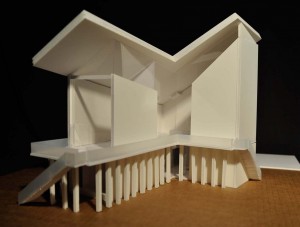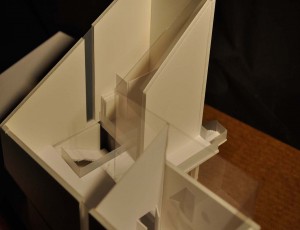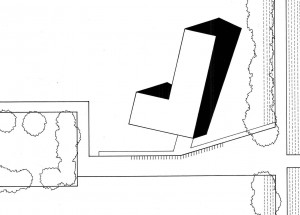Hwani Lee, “Museum #9066,” Fall 2013
 The design reflects my personal experience of the journey to the site. When we visited the site, I had a feeling that we finally arrived at a wide open field after a long drive on a narrow and curved path. It was a very dramatic experience for me. The building’s facade is odd with thick walls and a few windows that do not align with one another. It represents the oddness of the camp. The camp itself approached me as a hidden space (after the long way to get there). People knew what was going on, but it was not something they would want to be happy about.
The design reflects my personal experience of the journey to the site. When we visited the site, I had a feeling that we finally arrived at a wide open field after a long drive on a narrow and curved path. It was a very dramatic experience for me. The building’s facade is odd with thick walls and a few windows that do not align with one another. It represents the oddness of the camp. The camp itself approached me as a hidden space (after the long way to get there). People knew what was going on, but it was not something they would want to be happy about.
 The first floor is designed for offices. It allows only a little bit of natural light opening timidly towards the site. Unlike the first floor, the second floor allows lots of natural light and people will follow the light going up the stairs. As soon as they come up the stairs, they face a big glass walls and clerestory that shows the site’s view along with the memorial cemetery. After they look at the view through the glass wall, they open the massive door for the permanent exhibition, and it guides them to a total open view. At the permanent exhibition, they can go out to the balcony and experience the place physically.
The first floor is designed for offices. It allows only a little bit of natural light opening timidly towards the site. Unlike the first floor, the second floor allows lots of natural light and people will follow the light going up the stairs. As soon as they come up the stairs, they face a big glass walls and clerestory that shows the site’s view along with the memorial cemetery. After they look at the view through the glass wall, they open the massive door for the permanent exhibition, and it guides them to a total open view. At the permanent exhibition, they can go out to the balcony and experience the place physically.
 My building is a movie-like one. As I had the journey to the site, people will have a journey exploring the building, and will communicate with the site and historical facts more closely.
My building is a movie-like one. As I had the journey to the site, people will have a journey exploring the building, and will communicate with the site and historical facts more closely.


